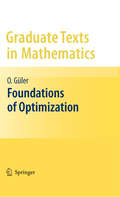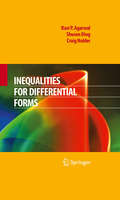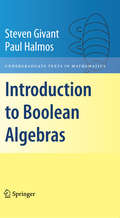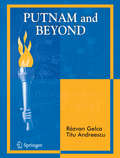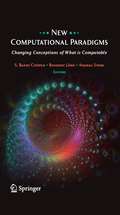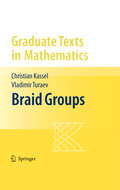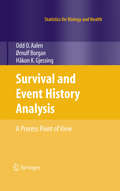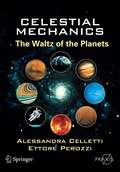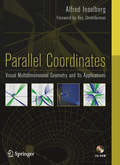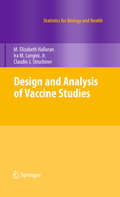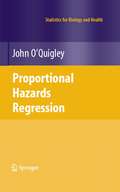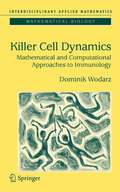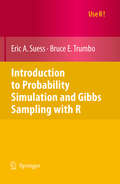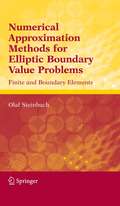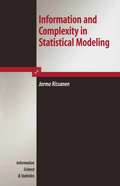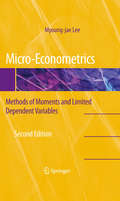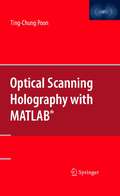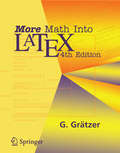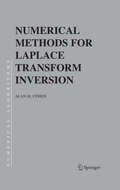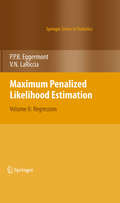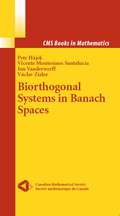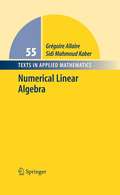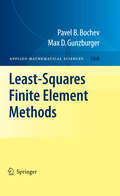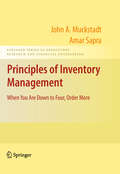- Table View
- List View
Inequalities for Differential Forms
by Ravi P. Agarwal Shusen Ding Craig NolderThis monograph is the first one to systematically present a series of local and global estimates and inequalities for differential forms, in particular the ones that satisfy the A-harmonic equations. The presentation focuses on the Hardy-Littlewood, Poincare, Cacciooli, imbedded and reverse Holder inequalities. Integral estimates for operators, such as homotopy operator, the Laplace-Beltrami operator, and the gradient operator are discussed next. Additionally, some related topics such as BMO inequalities, Lipschitz classes, Orlicz spaces and inequalities in Carnot groups are discussed in the concluding chapter. An abundance of bibliographical references and historical material supplement the text throughout. This rigorous presentation requires a familiarity with topics such as differential forms, topology and Sobolev space theory. It will serve as an invaluable reference for researchers, instructors and graduate students in analysis and partial differential equations and could be used as additional material for specific courses in these fields.
Putnam and Beyond
by Razvan Gelca Titu AndreescuPutnam and Beyond takes the reader on a journey through the world of college mathematics, focusing on some of the most important concepts and results in the theories of polynomials, linear algebra, real analysis in one and several variables, differential equations, coordinate geometry, trigonometry, elementary number theory, combinatorics, and probability. Using the W.L. Putnam Mathematical Competition for undergraduates as an inspiring symbol to build an appropriate math background for graduate studies in pure or applied mathematics, the reader is eased into transitioning from problem-solving at the high school level to the university and beyond, that is, to mathematical research.
Life Distributions: Structure of Nonparametric, Semiparametric, and Parametric Families (Springer Series in Statistics)
by Albert W. Marshall Ingram OlkinThis book is devoted to the study of univariate distributions appropriate for the analyses of data known to be nonnegative. The book includes much material from reliability theory in engineering and survival analysis in medicine.
New Computational Paradigms: Changing Conceptions of What is Computable
by S. B. Cooper Benedikt Löwe Andrea SorbiThis superb exposition of a complex subject examines new developments in the theory and practice of computation from a mathematical perspective, with topics ranging from classical computability to complexity, from biocomputing to quantum computing. This book is suitable for researchers and graduate students in mathematics, philosophy, and computer science with a special interest in logic and foundational issues. Most useful to graduate students are the survey papers on computable analysis and biological computing. Logicians and theoretical physicists will also benefit from this book.
Braid Groups (Graduate Texts in Mathematics #247)
by Christian Kassel Vladimir TuraevIn this well-written presentation, motivated by numerous examples and problems, the authors introduce the basic theory of braid groups, highlighting several definitions that show their equivalence; this is followed by a treatment of the relationship between braids, knots and links. Important results then treat the linearity and orderability of the subject. Relevant additional material is included in five large appendices. Braid Groups will serve graduate students and a number of mathematicians coming from diverse disciplines.
Survival and Event History Analysis: A Process Point of View (Statistics for Biology and Health)
by Odd Aalen Ornulf Borgan Hakon GjessingThe aim of this book is to bridge the gap between standard textbook models and a range of models where the dynamic structure of the data manifests itself fully. The common denominator of such models is stochastic processes. The authors show how counting processes, martingales, and stochastic integrals fit very nicely with censored data. Beginning with standard analyses such as Kaplan-Meier plots and Cox regression, the presentation progresses to the additive hazard model and recurrent event data. Stochastic processes are also used as natural models for individual frailty; they allow sensible interpretations of a number of surprising artifacts seen in population data. The stochastic process framework is naturally connected to causality. The authors show how dynamic path analyses can incorporate many modern causality ideas in a framework that takes the time aspect seriously. To make the material accessible to the reader, a large number of practical examples, mainly from medicine, are developed in detail. Stochastic processes are introduced in an intuitive and non-technical manner. The book is aimed at investigators who use event history methods and want a better understanding of the statistical concepts. It is suitable as a textbook for graduate courses in statistics and biostatistics.
Celestial Mechanics: The Waltz of the Planets (Springer Praxis Books)
by Alessandra Celletti Ettore PerozziThe aim of this book is to demonstrate to a wider audience, as well as to a more skilled audience, the many fascinating aspects of modern celestial mechanics. It sets out to do this without the use of mathematics. After giving the reader the technical tools needed for a basic understanding of the underlying physical phenomena (using only elementary mathematics), facts and figures are provided on historical events, modern discoveries and future applications. Contents are divided into major topics where the three "souls" of modern celestial mechanics (dynamical systems, Solar System and stellar systems, spaceflight dynamics) play a major role.
Parallel Coordinates: Visual Multidimensional Geometry and Its Applications
by Alfred InselbergThis is one book that can genuinely be said to be straight from the horse’s mouth. Written by the originator of the technique, it examines parallel coordinates as the leading methodology for multidimensional visualization. Starting from geometric foundations, this is the first systematic and rigorous exposition of the methodology's mathematical and algorithmic components. It covers, among many others, the visualization of multidimensional lines, minimum distances, planes, hyperplanes, and clusters of "near" planes. The last chapter explains in a non-technical way the methodology's application to visual and automatic data mining. The principles of the latter, along with guidelines, strategies and algorithms are illustrated in detail on real high-dimensional datasets.
Design and Analysis of Vaccine Studies: (pdf) (Statistics for Biology and Health)
by M. Elizabeth Halloran Claudio J. Struchiner Ira M. Longini Jr.Proportional Hazards Regression (Statistics for Biology and Health)
by John O'QuigleyThe place in survival analysis now occupied by proportional hazards models and their generalizations is so large that it is no longer conceivable to offer a course on the subject without devoting at least half of the content to this topic alone. This book focuses on the theory and applications of a very broad class of models – proportional hazards and non-proportional hazards models, the former being viewed as a special case of the latter – which underlie modern survival analysis. Researchers and students alike will find that this text differs from most recent works in that it is mostly concerned with methodological issues rather than the analysis itself.
Killer Cell Dynamics: Mathematical and Computational Approaches to Immunology (Interdisciplinary Applied Mathematics #32)
by Dominik WodarzThis book reviews how mathematical and computational approaches can be useful to help us understand how killer T-cell responses work to fight viral infections. It also demonstrates, in a writing style that exemplifies the point, that such mathematical and computational approaches are most valuable when coupled with experimental work through interdisciplinary collaborations. Designed to be useful to immunoligists and viroligists without extensive computational background, the book covers a broad variety of topics, including both basic immunological questions and the application of these insights to the understanding and treatment of pathogenic human diseases.
Introduction to Probability Simulation and Gibbs Sampling with R (Use R!)
by Eric A. Suess Bruce E. TrumboThe first seven chapters use R for probability simulation and computation, including random number generation, numerical and Monte Carlo integration, and finding limiting distributions of Markov Chains with both discrete and continuous states. Applications include coverage probabilities of binomial confidence intervals, estimation of disease prevalence from screening tests, parallel redundancy for improved reliability of systems, and various kinds of genetic modeling. These initial chapters can be used for a non-Bayesian course in the simulation of applied probability models and Markov Chains. Chapters 8 through 10 give a brief introduction to Bayesian estimation and illustrate the use of Gibbs samplers to find posterior distributions and interval estimates, including some examples in which traditional methods do not give satisfactory results. WinBUGS software is introduced with a detailed explanation of its interface and examples of its use for Gibbs sampling for Bayesian estimation. No previous experience using R is required. An appendix introduces R, and complete R code is included for almost all computational examples and problems (along with comments and explanations). Noteworthy features of the book are its intuitive approach, presenting ideas with examples from biostatistics, reliability, and other fields; its large number of figures; and its extraordinarily large number of problems (about a third of the pages), ranging from simple drill to presentation of additional topics. Hints and answers are provided for many of the problems. These features make the book ideal for students of statistics at the senior undergraduate and at the beginning graduate levels.
Numerical Approximation Methods for Elliptic Boundary Value Problems: Finite and Boundary Elements
by Olaf SteinbachThis book presents a unified theory of the Finite Element Method and the Boundary Element Method for a numerical solution of second order elliptic boundary value problems. This includes the solvability, stability, and error analysis as well as efficient methods to solve the resulting linear systems. Applications are the potential equation, the system of linear elastostatics and the Stokes system. While there are textbooks on the finite element method, this is one of the first books on Theory of Boundary Element Methods. It is suitable for self study and exercises are included.
Information and Complexity in Statistical Modeling (Information Science and Statistics)
by Jorma RissanenNo statistical model is "true" or "false," "right" or "wrong"; the models just have varying performance, which can be assessed. The main theme in this book is to teach modeling based on the principle that the objective is to extract the information from data that can be learned with suggested classes of probability models. The intuitive and fundamental concepts of complexity, learnable information, and noise are formalized, which provides a firm information theoretic foundation for statistical modeling. Although the prerequisites include only basic probability calculus and statistics, a moderate level of mathematical proficiency would be beneficial.
Micro-Econometrics: Methods of Moments and Limited Dependent Variables
by Myoung-jae LeeUp-to-date coverage of most micro-econometric topics; first half parametric, second half semi- (non-) parametric Many empirical examples and tips in applying econometric theories to data Essential ideas and steps shown for most estimators and tests; well-suited for both applied and theoretical readers
Optical Scanning Holography with MATLAB®
by Ting-Chung PoonOptical Scanning Holography is an exciting new field with many potential novel applications. This book contains tutorials, research materials, as well as new ideas and insights that will be useful for those working in the field of optics and holography. The book has been written by one of the leading researchers in the field. It covers the basic principles of the topic which will make the book relevant for years to come.
More Math Into LaTeX
by George GrätzerThis is the fourth edition of the standard introductory text and complete reference for scientists in all disciplines, as well as engineers. This fully revised version includes important updates on articles and books as well as information on a crucial new topic: how to create transparencies and computer projections, both for classrooms and professional meetings. The text maintains its user-friendly, example-based, visual approach, gently easing readers into the secrets of Latex with The Short Course. Then it introduces basic ideas through sample articles and documents. It includes a visual guide and detailed exposition of multiline math formulas, and even provides instructions on preparing books for publishers.
Numerical Methods for Laplace Transform Inversion (Numerical Methods and Algorithms #5)
by Alan M. CohenThis book gives background material on the theory of Laplace transforms, together with a fairly comprehensive list of methods that are available at the current time. Computer programs are included for those methods that perform consistently well on a wide range of Laplace transforms. Operational methods have been used for over a century to solve problems such as ordinary and partial differential equations.
Maximum Penalized Likelihood Estimation: Volume II: Regression (Springer Series in Statistics)
by Paul P. Eggermont Vincent N. LaRicciaUnique blend of asymptotic theory and small sample practice through simulation experiments and data analysis. Novel reproducing kernel Hilbert space methods for the analysis of smoothing splines and local polynomials. Leading to uniform error bounds and honest confidence bands for the mean function using smoothing splines Exhaustive exposition of algorithms, including the Kalman filter, for the computation of smoothing splines of arbitrary order.
Biorthogonal Systems in Banach Spaces (CMS Books in Mathematics)
by Petr Hajek Vicente Montesinos Santalucia Jon Vanderwerff Vaclav ZizlerThis book introduces the reader to some of the basic concepts, results and applications of biorthogonal systems in infinite dimensional geometry of Banach spaces, and in topology and nonlinear analysis in Banach spaces. It achieves this in a manner accessible to graduate students and researchers who have a foundation in Banach space theory. The authors have included numerous exercises, as well as open problems that point to possible directions of research.
Numerical Linear Algebra (Texts in Applied Mathematics #55)
by Grégoire Allaire Sidi Mahmoud KaberThis book distinguishes itself from the many other textbooks on the topic of linear algebra by including mathematical and computational chapters along with examples and exercises with Matlab. In recent years, the use of computers in many areas of engineering and science has made it essential for students to get training in numerical methods and computer programming. Here, the authors use both Matlab and SciLab software as well as covering core standard material. It is intended for libraries; scientists and researchers; pharmaceutical industry.
Least-Squares Finite Element Methods (Applied Mathematical Sciences #166)
by Pavel B. Bochev Max D. GunzburgerSince their emergence, finite element methods have taken a place as one of the most versatile and powerful methodologies for the approximate numerical solution of Partial Differential Equations. These methods are used in incompressible fluid flow, heat, transfer, and other problems. This book provides researchers and practitioners with a concise guide to the theory and practice of least-square finite element methods, their strengths and weaknesses, established successes, and open problems.
Principles of Inventory Management: When You Are Down to Four, Order More (Springer Series in Operations Research and Financial Engineering)
by John A. Muckstadt Amar SapraInventories are prevalent everywhere in the commercial world, whether it be in retail stores, manufacturing facilities, government stockpile material, Federal Reserve banks, or even your own household. This textbook examines basic mathematical techniques used to sufficiently manage inventories by using various computational methods and mathematical models. The text is presented in a way such that each section can be read independently, and so the order in which the reader approaches the book can be inconsequential. It contains both deterministic and stochastic models along with algorithms that can be employed to find solutions to a variety of inventory control problems.With exercises at the end of each chapter and a clear, systematic exposition, this textbook will appeal to advanced undergraduate and first-year graduate students in operations research, industrial engineering, and quantitative MBA programs. It also serves as a reference for professionals in both industry and government worlds. The prerequisite courses include introductory optimization methods, probability theory (non-measure theoretic), and stochastic processes.
